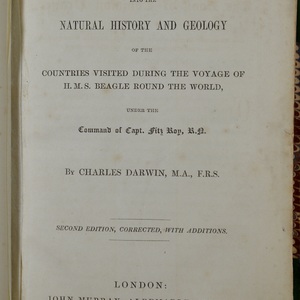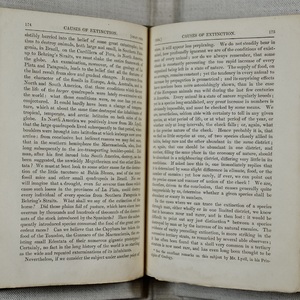-
Title
-
Voyage of H.M.S. Beagle Round the World
-
Caption
-
Charles Darwin’s (1809-1882) narrative of his voyage around the globe features the famous Galapagos finches whose beaks helped him develop his theory of evolution by natural selection. By observing the incredible variety of beak shapes among finch species, he postulated that the beak of an ancestral finch who had arrived at the remote island chain had adapted over time to equip the finches to acquire different food sources. Drawing on the diversity of Galapagos finches and other animals he encountered as examples of evolution by natural selection, Darwin’s theory fundamentally changed human understanding of species and how ecosystems change over time. Darwin posited that many species have died out as a result of competition between animals, and that this process had occurred gradually and continuously throughout the history of life. However, he neglected to clarify the role humans can play in driving species extinction, and believed that sudden disappearances of many species, or mass extinctions, did not actually occur.
-
Creator
-
Charles Darwin
-
Date Created
-
1845
-
Publisher
-
J. Murray
-
Place of Publication
-
London, England
-
Rights
-
No Known Copyright
-
Bibliographic Citation
-
Charles Darwin. Journal of Researches into the Natural History and Geology of the Countries Visited During the Voyage of H.M.S. Beagle Round the World: Under the Command of Capt. Fitz Roy 2nd ed., corr. with additions. London: J. Murray, 1845. Rare Book QH11 .D2 1845
-
Filename
-
exh-vanishing_Darwin_001.jpeg
-
exh-vanishing_Darwin_002.jpeg
-
exh-vanishing_Darwin_003.jpeg
-
Case Number
-
Understanding Extinction - Species & Human Impacts
-
Item Number
-
3



